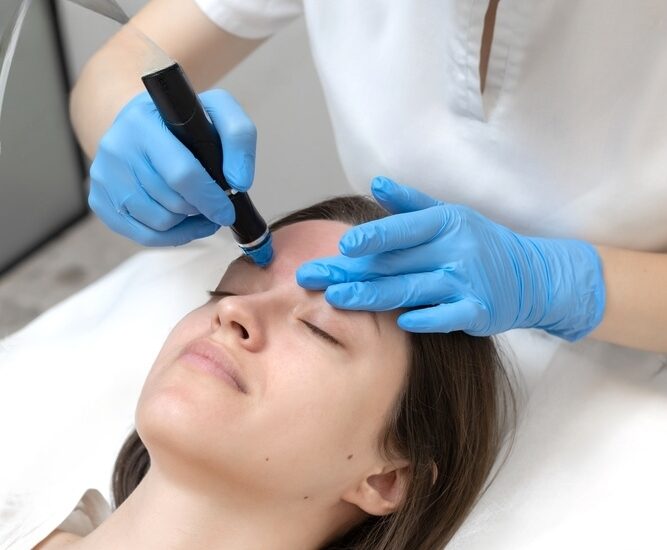In medical terms, excessive sweating is referred to as hyperhidrosis, a condition characterized by the body’s uncontrolled production of sweat. This phenomenon often results in embarrassing underarm odor and unsightly stains on clothing. Importantly, hyperhidrosis is not solely triggered by high temperatures or intense physical activity, but rather by underlying factors such as underlying medical conditions. There are two distinct forms of hyperhidrosis, each with its unique characteristics and causes.
Secondary hyperhidrosis, on the other hand, is triggered by underlying medical conditions, such as diabetes, hormonal fluctuations during pregnancy or menopause, and certain neurological disorders like Parkinson’s disease. Additionally, certain medications, including naproxen, and even supplements like zinc, can inadvertently cause excessive sweating as a side effect, contributing to the development of secondary hyperhidrosis.
While the initial effects of microneedling may be noticeable, optimal results typically require a series of 5 to 8 sessions. The longevity of the results, which can last several months to years, depends on the number of sessions and individual skin performance. The expertise of the practitioner also plays a significant role in achieving desirable outcomes. To maintain and enhance the results, it’s essential to follow the practitioner’s post-treatment instructions carefully, as neglecting proper skincare may compromise the effectiveness of the treatment.
Iontophoresis is a non-invasive treatment that involves immersing the hands or feet in a water bath, while a specialized machine delivers mild electrical currents to temporarily block sweat glands. This procedure typically takes around 30 minutes to complete and requires weekly sessions for optimal results.
For those seeking more permanent solutions, several options are available. Microwave therapy utilizes a specialized machine to emit heat energy, damaging or destroying the sweat glands in the treated area. This procedure yields irreversible results. Alternatively, laser treatment employs concentrated light beams to target and reduce sweat glands, typically requiring multiple sessions. As a last resort, surgical interventions can be considered, such as removing the nerves that stimulate sweat glands or excising the underarm sweat glands altogether. However, it is crucial to thoroughly discuss potential complications with your doctor before undergoing surgery, as these procedures are irreversible.
While hyperhidrosis is not a life-threatening condition, it can significantly impact daily life, exacerbating social anxiety and eroding self-confidence. The persistent odor associated with excessive sweating can be particularly distressing. Fortunately, seeking treatment can help restore confidence and facilitate social interactions. Although hyperhidrosis may not pose physical health risks, its emotional and psychological toll can be substantial, making prompt treatment essential to mitigate its effects on mental well-being.
Treating hyperhidrosis can be a life-changing decision, offering numerous benefits that can greatly enhance your overall quality of life. By addressing excessive sweating, you can regain confidence in your social interactions, enjoy a wider range of clothing options without anxiety, and say goodbye to embarrassing body odor. This treatment also eliminates the need for costly deodorants and frees you from restrictive eating habits. Ultimately, treating hyperhidrosis empowers you to live life on your own terms, unencumbered by the constant worry of excessive sweating.
Before undergoing treatment, a proper diagnosis is essential to confirm the presence of hyperhidrosis. Excessive sweating can have various causes, and misdiagnosis can lead to ineffective treatment and potential side effects. To determine if you have hyperhidrosis, your doctor will conduct a series of tests. If the results are negative, your sweating may be attributed to environmental factors, anxiety, or other reasons. However, if the tests confirm hyperhidrosis, your doctor will develop a personalized treatment plan based on the severity of your condition.
The cost of hyperhidrosis treatment varies widely, influenced by several factors. These include the surgeon’s or consulting doctor’s fee, the cost of materials and equipment, the type and complexity of the treatment, and the number of sessions required. Additionally, the location and amenities of the clinic, as well as the desired outcome, also play a role in determining the overall cost. Furthermore, the choice of treatment option significantly impacts the cost and duration of results. While more affordable options may offer temporary relief, investing in more expensive treatments can yield longer-lasting results, ultimately providing better value for money.
Insurance coverage for hyperhidrosis treatment is generally limited, with only a few cases qualifying for reimbursement. However, if your excessive sweating is a secondary condition, resulting from a underlying chronic illness, you may be eligible for insurance coverage. In such cases, it’s possible to get your insurance provider to cover the treatment costs.













